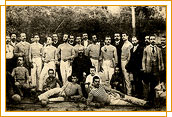Professionals and amateurs
According to the first regulation of the International Olympic Committee, which was voted in 1894, only amateur athletes were accepted in the Olympic Games.  This reflects one of the dominant themes of the 19th century regarding athletics, that is the conflict between professionalism and amateurism. The early movement in favor of amateurism was not a movement against profit resulting from athletics. Mostly it reflected an already established situation in the societies of Western Europe and America, where athletics more and more was a way for the members of the middle and upper classes to pass their free time. Especially regarding the Greek society of that period, the relevant discussion turned also against the participation of the members of the lower social strata. This reflects one of the dominant themes of the 19th century regarding athletics, that is the conflict between professionalism and amateurism. The early movement in favor of amateurism was not a movement against profit resulting from athletics. Mostly it reflected an already established situation in the societies of Western Europe and America, where athletics more and more was a way for the members of the middle and upper classes to pass their free time. Especially regarding the Greek society of that period, the relevant discussion turned also against the participation of the members of the lower social strata.
Even before 1896, in 1870, during the Zappian Olympic Games, Philippos Ioannou, classical scholar and professor, was one of those that criticised the games. He attacked the games inspired by the ideal of amateurism: he said that modern Olympics was a parody, because some workers have participated, people that were mostly identified with their profession. The winner of the 400 meters race was a butcher; Trougas, the winner of climbing the pole, was a stone craftsman; Kardamilakis, a wrestler Olympic victor, was a simple worker. So, people from the working class had taken part in the Olympic Games of 1870. Ioannou suggested that only young people from the upper class should be accepted in the following Olympiad. In the following Olympic Games, in 1875, participation was allowed only to the men of the "educated class", that is graduates of high school and university.
The various athletic clubs that had been established contributed to the social control of the athletes. Usually, distinguished representatives of the Greek society became members of the clubs, such as lawyers, politicians, professors etc. After the establishment of the athletic clubs, all athletes should become members of a club.
The most important athletic association was the Panhellenic Gymnastics Club, which was established in 1891 by distinguished member of the Greek society with its first president Ioannis Fokianos. When it was founded, it organised athletic contests in the municipal Gymnasium of Athens. This event included track, wrestling, weight lifting and gymnastics. It was considered very important for the Athenian society and even the royal family attended it.
In 1894 Panhellenic Gymnastics Club participated in the International Athletic Congress in Paris. His representative was Dimitrios Vikelas, the man who contributed a lot to the organisation of the first modern Olympic Games. In the Olympic Games of 1896, ten members of Panhellenic Gymnastics Club became Olympic victors.
|
